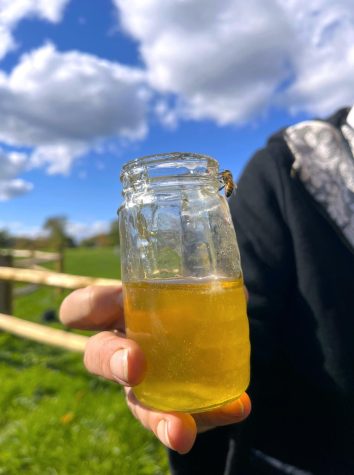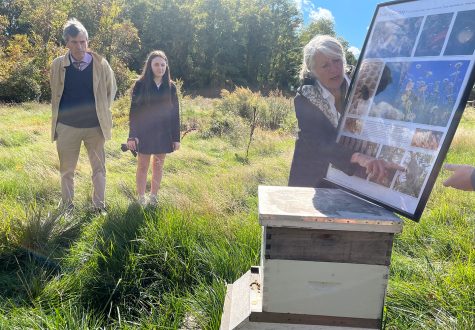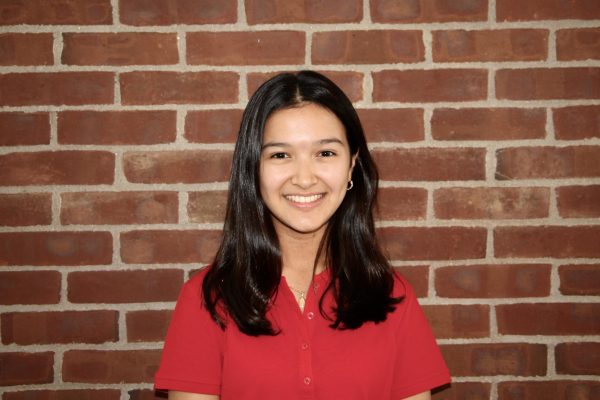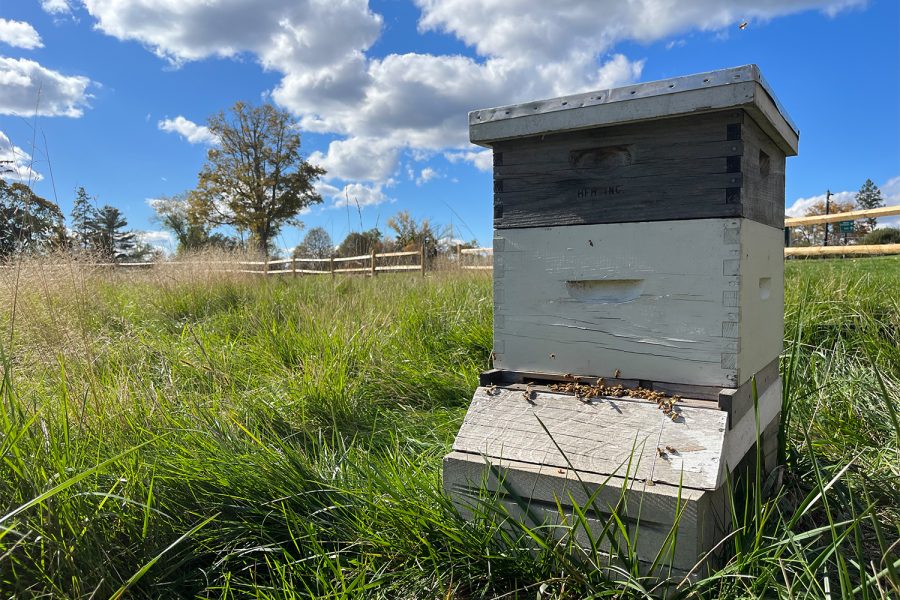Campus environmental initiatives are abuzz this winter
The Sacred Heart honeybees return to their hives for the winter as the Environmental Stewardship Committee works for campus sustainability.
As carols and Christmas cheer fill the halls of Sacred Heart Greenwich, the campus honeybees prepare for the cold months ahead. Students from the Lower School and the Upper School have worked to ensure the honeybees’ winter safety, bundling up to visit the hives with Ms. Margaret Vondermeden, the Mustard Seed Program Teacher. The Environmental Stewardship Committee (ESC) is also abuzz this season, and its founders, juniors Jane Cary and Emily Sedgwick, spoke about new environmental initiatives such as the composting program to promote climate awareness.
For honeybees, who weigh less than an ounce, winter is not such a wonderland. In fact, the challenge of surviving the freezing temperatures requires a new generation of winter bees, whose physical traits are distinct and specialized for their tasks. The cold-weather bees are larger and longer-lived than their summer counterparts, and the males die off in the winter, leaving an all-female colony to carry the hive through to the spring, according to theapiarist.org.

While people gather around the holiday table to celebrate family and friends, bees also rely on their communities for survival. When temperatures fall below 50 degrees Fahrenheit, the bees cluster around the queen, quivering and shaking their bodies and wings. This motion creates heat and condensation for the bees to drink. The clustered bees maintain a temperature of 90 to 100 degrees Fahrenheit until the winter thaws, warming each other and the queen to survive the snow and frost beyond the hive, according to britannica.com.
The bees also depend on a supply of honey, as they collectively consume between 60 and 70 pounds during the winter. They crawl around their food stores of honey in a rotating formation, taking turns at both the warmest and coldest positions on the cluster.
Ms. Vondermeden taught students, including members of the ESC, how to winterize the hives in November. Since this is the first winter for the Sacred Heart hives, Ms. Vondermeden ensured that the campus colonies had food and secure shelter, including a metal plate to guard against mice seeking to live in the hive. Ms. Vondermeden commented on the benefits of bee-keeping, both for pollination and for education.
“Honeybees teach us to see the environment through a different lens,” Ms. Vondermeden said. “There are many reasons to become not only a bee-keeper but a bee steward. Honeybees do not need us, but we need them, as they are responsible for every third bite we take.”
Jane, who co-founded the ESC this year, is proud of the school for its honeybee initiative. She discussed this unique, hands-on experience and her hopes to see more environmentally-aware changes within the school. Jane shared what drives her to seek climate solutions through the ESC.

“Of course, fear of the climate crisis is a pretty big motivator for me, but more than that, compassion motivates me to engage with the environment,” Jane said. “To know that people around the world are all being affected differently–some worse than others–as well as the damage humans have caused to the natural environments and habitats of animals really drives me to do what I can and participate in environmental causes. Even if what we’re doing has a small impact, any impact makes a difference.”
This winter, after readying the honeybees for the cold season, the ESC turned its focus to composting. Students posted signage on waste containers throughout the school to encourage awareness of how to sort disposal correctly. The ESC is currently working to establish a lunchroom composting program, which will begin in the student dining hall the first week after winter break.
The ESC has also harvested seeds to spread in the campus’ native meadow and planted bulbs for the spring. Co-founder Emily stated her gratitude for the support and excitement of the students, faculty, and grounds crew for the ESC.

“Students have had such a positive response to our meeting times during GOALS,” Emily said. “I have seen so many members of our community come outside with us to explore the little things in our school environment that make the biggest difference. The bees are such an engaging way to bond over our common passion for Environmental Stewardship.”
Ms. Vondermeden detailed her hopes for the honeybee initiative at Sacred Heart, noting that the school already owns bee suits to allow for interactive bee-keeping. She mentioned forming an interdivisional bee-keeping club to build community as well as awareness.
“The ideas are endless and will depend on the interest and how far students wish to take it,” Ms. Vondermeden said.
Looking towards the future, the ESC discussed addressing the school’s energy use, formulating a land acknowledgment statement, and integrating Sacred Heart’s outdoor resources into the curriculum. Jane described her aspirations for the program.
“Going forward, I hope the ESC can educate Sacred Heart students further on all different environmental topics ranging from climate change to the school’s own environment,” Jane said. “I also hope we can encourage the school to make small but impactful changes to become even more environmentally-conscious.”
Featured Image by Avery Kim ’24

Avery is honored to serve as one of the Editors-in-Chief of the King Street Chronicle. After two years on the newspaper’s staff, she has learned countless...



Leah Allen • Dec 13, 2022 at 1:07 pm
Great work Avery! I’ve loved reading your pieces all year